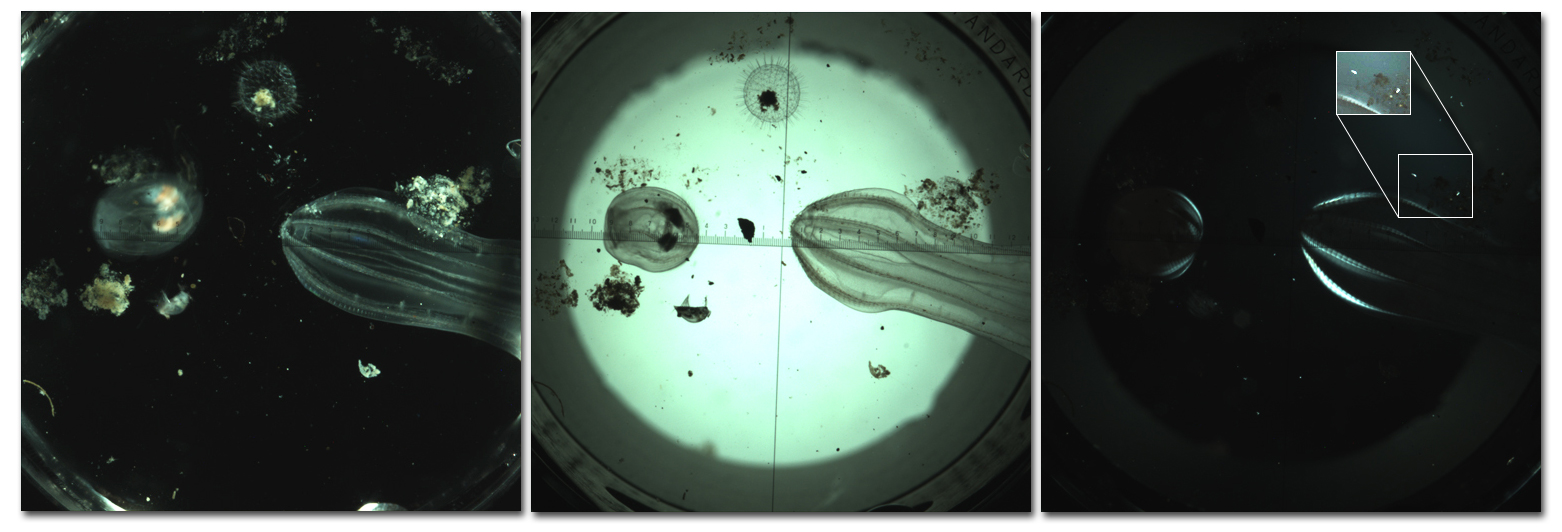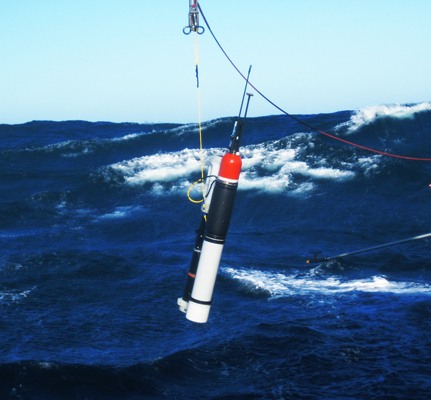Carbon Explorer floats follow ocean currents, yo-yoing back and forth in the first kilometer below the surface of the sea, then resurfacing to report their data and receive new instructions via satellite. Since the early 2000s a dozen Carbon Explorers have produced detailed information on the carbon cycle in the Atlantic, Pacific, and Southern Oceans – information that would be unaffordable and in some cases impossible to obtain from shipboard. Working 24/7 for voyages of up to a year or more, they’ve compiled an average of 350 kilometers (217 miles) of up-and-down ocean profiling per float, and they continue to rack up impressive results.
Carbon Explorers were developed at Lawrence Berkeley National Laboratory (Berkeley Lab) by Jim Bishop of the Earth Sciences Division, who is also a professor of Earth and Planetary Science at the University of California at Berkeley. Carbon Explorers are based on the temperature-and-salinity floats called SOLOs, pioneered by the Scripps Institution of Oceanography. On July 29 Bishop’s newest generation of Carbon Explorers, called Carbon Flux Explorers, set out from Monterey Bay aboard the Research Vessel Point Sur, operated by Moss Landing Marine Laboratories.
This test of three Carbon Flux Explorers follows close on the heels of a strenuous and storm-tossed trial of the first of the new breed in the Channel Islands in June, but these three will be launched two hundred kilometers out in the open ocean, in the heart of the California Current – the same strong current that swept many a Spanish galleon right past the Golden Gate in the two centuries before San Francisco Bay was discovered by land.

A series from the new Carbon Flux Explorer’s optical sedimentation recorder shows three views of the same collection of carbon-containing particles and live invading organisms, which descend from surface waters at dawn (shown for their beauty, although they rarely get into the system). The images are 26 millimeters across, a little over an inch, and resolution is 10 millionths of a meter. The three lighting modes are, left, dark field (side) illumination; middle, transmitted light; and right, cross-polarized light, which can detect birefringent calcium carbonate – the small, very bright particles – and structures in some organisms. Two living larval ctenophores (comb jellies) are at left and right. The buckyball shape at top is a dead radiolarian, a one-celled animal with a silica skeleton. The carbon sedimentation is composed of a half-dozen amorphous aggregates and a dead crustacean. (Click on image for best resolution.)
Tough autonomous robots to measure ocean carbon
Basic Carbon Explorers work by collecting and measuring the concentration of particulate organic carbon, charting how these concentrations follow the day-and-night rhythms of primary production of oceanic plant life and feeding by oceanic animals. Much of the variation is due to phytoplankton, plants that absorb carbon dioxide from the atmosphere.
In 2001, at Ocean Station PAPA in the North Pacific, Carbon Explorers made the first observation that iron-rich windblown dust (in this instance from the Ghobi Desert in Asia) stimulates phytoplankton blooms in ocean areas otherwise rich in nutrients but lacking essential iron. Contrary to expectations, however, the Carbon Explorers showed that these iron-stimulated blooms last only a short time.
In 2002 and 2003, a 14-month deployment in the Southern Ocean saw two Carbon Explorers riding out an Antarctic winter in the latitudes of the “howling 50’s” while a third spent the winter in the “screaming 60s,” three months of that time under the ice. The Carbon Explorers helped establish that plankton blooms can be fertilized by adding iron artificially – even in waters poor in silica, which many plant species need to form their cell walls. Over the next year, however, two of the floats compiled data revealing that not much of the carbon from the plankton blooms made it to the deep ocean for permanent storage. So far, artificially fertilizing the ocean with iron does not look like a good plan for soaking up excess carbon dioxide in the atmosphere.
Basic Carbon Explorers depend on transmissometers to estimate how much carbon-containing material is in the water, by measuring how much light can get through a glass plate on which the material collects. This past June, Bishop and his team set sail from San Diego aboard the Scripps Institution’s Research Vessel New Horizon to test the new breed of Carbon Flux Explorer and its new instrument system.
A Carbon Flux Explorer not only measures overall carbon sedimentation, it can determine exactly what’s in each sample, for example how much of the carbon is locked up in calcium carbonate (so-called particulate inorganic carbon), which is heavy enough to act as ballast to carry carbon into the deep.

The first new Carbon Flux Explorer test float was deployed on June 27, 2011, in a fast-rising gale that soon forced the ship to head into the wind and leave the float on its own.
Says Bishop, “Carbon Flux Explorers will do for the mechanisms of carbon sedimentation what Carbon Explorers did for biomass variability. We’ll be able to see the arms, legs, bodies, fecal pellets, and shapeless aggregates that make up the material falling into the deep sea.”
The camera system will measure sedimentation on hourly time scales for entire seasons, at different locations around the globe, making it possible to calculate how much carbon in particle form is being delivered to the deep sea. It can also be used to measure how increasing acidification (because carbon dissolved in sea water forms carbonic acid) affects the formation of calcium-carbonate phytoplankton shells and skeletons. Knowing what’s in the sediment, including what’s eating the detritus, adds essential knowledge for understanding the ocean carbon cycle.
“Every day organisms swim up from the deep to feed,” says Bishop. “The process results in a huge amount of organic carbon that rides sinking particles from the sunlit layer into deeper water” – some 10 quadrillion grams of carbon globally each year – “and no one has sampled this variability.”
Bishop adds, “Until we understand bioresponses to waves and light and the elements, all the physics and chemistry, we’re flying without a flight plan, unable to predict whether the future will bring a strengthening, which would be good, or weakening, which would be bad, of this so-called ocean biological carbon pump.”
The new Carbon Flux Explorer not only carries a new instrument, it’s simpler, more robust, and weighs substantially less than earlier versions; it has an all-new pressure case and uses much less energy to power its more sophisticated computational, data storage, and communications electronics – technological improvements that mesh with Berkeley Lab’s research into better batteries and more efficient lighting.
Into the storm
Launched from the RV New Horizon on June 27th into the waters of the Channel Islands, the test float was programmed to descend to depth and resurface on schedule. After each collection and recording the optical system was flushed out and new sedimentation was allowed to accumulate.
At the same time, similar instruments were deployed from a surface buoy, hung 250 meters down; after each of the buoy’s “photography sessions,” the actual particles were collected in bottles for control and comparison with the results from the float.
Even as the free float and the control buoy were being launched, the wind was rising; by that afternoon the gale had increased to 45 knots. To ride out the storm, the ship could only point into the wind.
“We couldn’t do any work for a day and a half,” Bishop says. “At one point the ship took a roll that sent stuff flying – even the gear that was tied down to a table in the laboratory went across the room when the table ripped out of the wall.”

After three stormy days the weather abated and the unperturbed Carbon Flux Explorer was lifted from the sea. Throughout the storm the float had continued to surface and send its position and data to the ship via satellite.
For the next three days the Carbon Flux Explorer float was subjected to a “torture test,” but, says Bishop, “no data was lost. Every time it surfaced, within minutes it sent us its location and data via satellite – the major hurdle it had to pass.”
When the gale finally abated, the float and the instrumented surface buoy were recovered, and the RV New Horizon made its way back to port, concluding a successful cruise.
The more severe test of the three Carbon Flux Explorers that began on July 29 is much longer; after launch from the RV Point Sur, the floats are left to themselves for a month before the ship returns to pick them up.
“We’re teaching the technology to crawl and then walk and then run,” says Bishop. “Next year we’ll return to Ocean Station PAPA in the North Pacific, where the first pair of Carbon Explorers was deployed 10 years ago, and kick a couple of the new Carbon Flux Explorers over the side.” The floats will transmit their high-frequency sedimentation data to shore in real time via satellite. “This promises a new, revolutionary view of the largely unobserved process of ocean carbon sedimentation. If we’re lucky, we’ll get them back in six months for a complete assessment of their performance.”
Additional information
Berkeley Lab and UC Berkeley personnel aboard the RV New Horizon for the June test were Jim Bishop, Todd Wood, and Alex Morales of the Earth Sciences Division, UC Berkeley students Gabrielle Weiss, Ralph Till, Nolan Wong, Ernesto Martinez, Andrew Bower, Nin Gan, and Paul Lerner – many of whom have worked in Bishop’s lab – and engineer Wes Strubhar from WET Labs, Inc., which makes underwater instrumentation. Long under development in Berkeley Lab’s Engineering Division, with help from Yoichi Kajiyama, Robert Altes, and designers Raymond Low and David Beck, the Carbon Flux Explorer’s principal instruments are now on the verge of being made commercially available to ocean researchers around the world. Recent work with Carbon Flux Explorers was funded through UC Berkeley by the National Science Foundation’s Ocean Technology and Interdisciplinary Coordination Program.